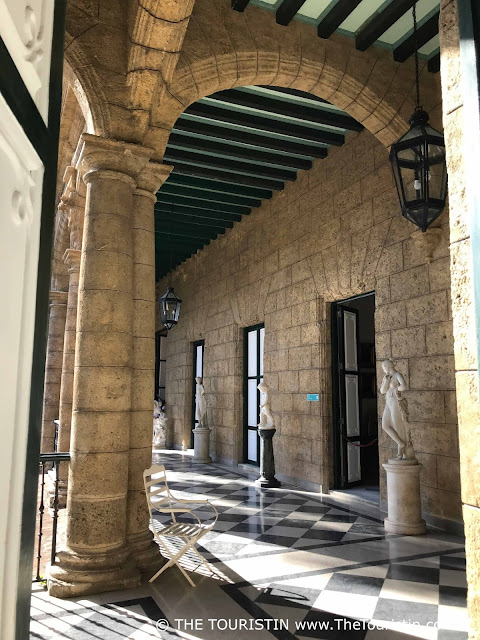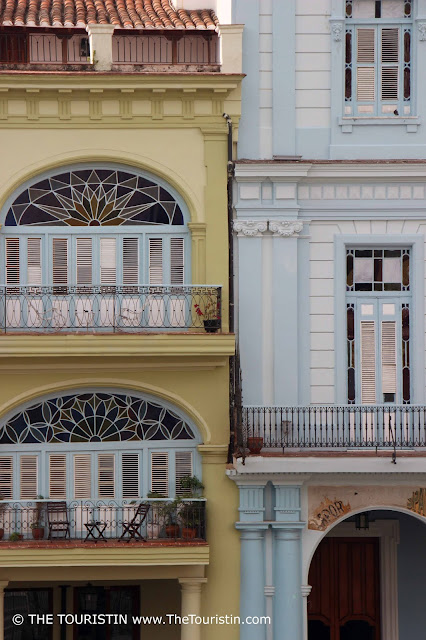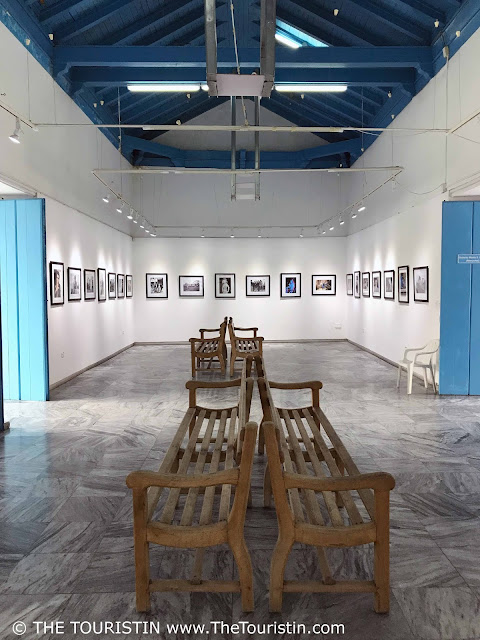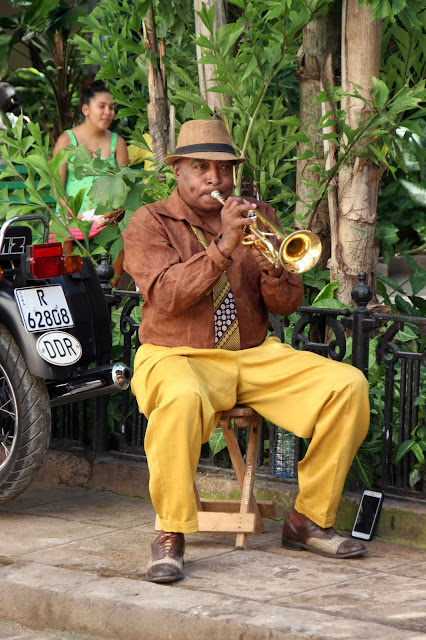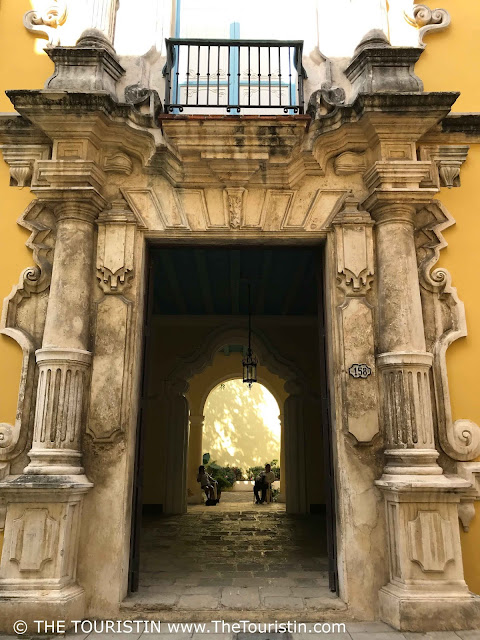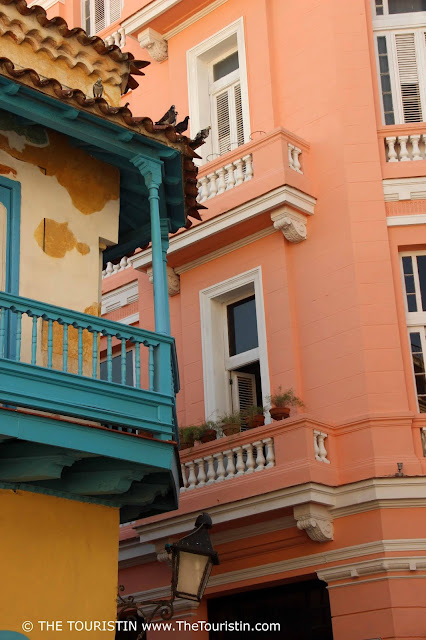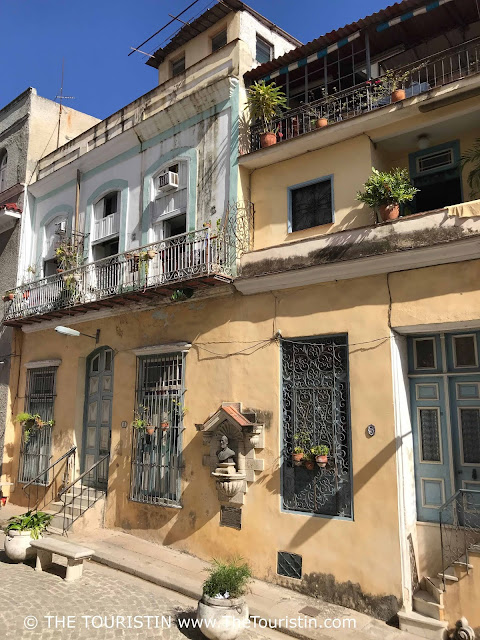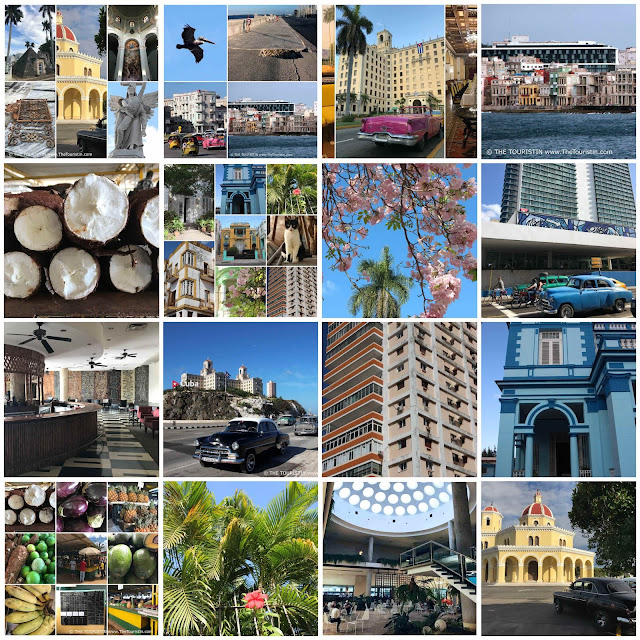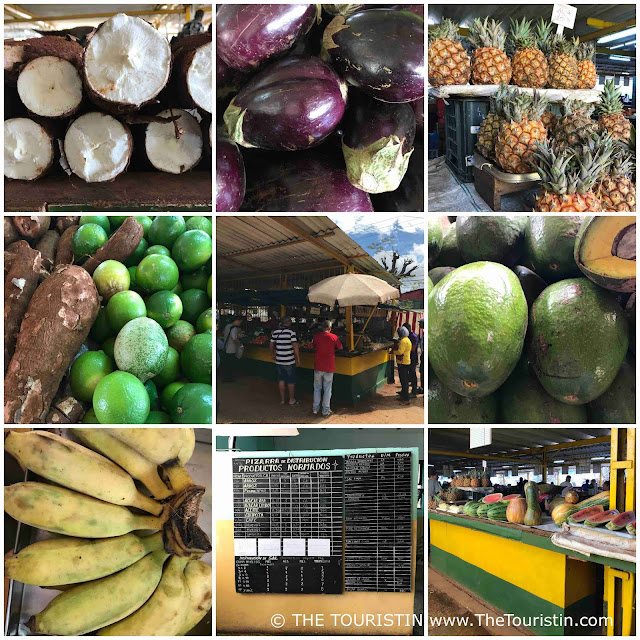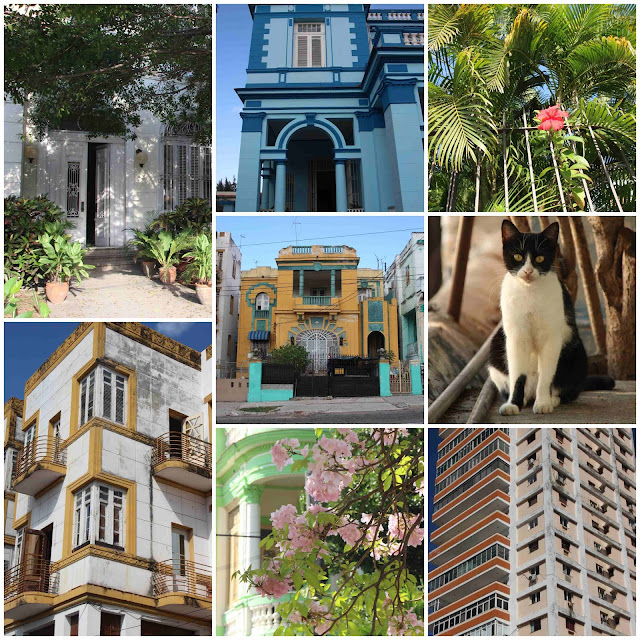We all know that fantastic
travel experiences are not about how far we travel, it is all about what we
discover and learn along the way. I had huge adventures in my own
neighbourhood, this time I decided to search for them in Cuba. Cuba is the
largest Caribbean island, where you can travel 1,200 kilometres from west to
east. Almost two million of the about 12 million live in the capital Havana.
Old Havana was declared World
Heritage site in the 1980s. If you walk around town you will see Soviet Ladas
next to 1950 classic US cars inclusive the heavy exhaust fumes that come with
them; smiling kids playing ball in the street, stately palaces in ruins,
mountains of rubbish piling up on the streets, dirty looking water leaks,
unidentifiable smells, passionate musicians, dancers and live music in
literally every café and restaurant, old and young neighbours chatting, cute
and lazy cats, friendly and tired looking dogs, beautiful restored stately
palaces and plazas. It is a wild and interesting mix. Just by walking around aimlessly you discover breathtakingly beautiful
scenes and architecture. The beauty of Havana is that nothing is set in stone.
Every day brings new exciting discoveries. Are you a seeker of everyday magic
too?
It is easy to have fun on
vacation in Cuba, when ignoring the overall situation. In large parts, Havana
seemingly lies in ruins, so many streets look like there was a war. Before I
booked my trip, the only thing I knew is how amazing it is going to be to take
all these awesome photos of abandoned houses and places. And yes, that is
exciting. The photo opportunities are phenomenal, if it wouldn’t be this
tragic. The revolution happened 60 years ago, and still, to this day people
live in poverty, they have to find ways to just get by. The fact that every
Cuban is well educated, and that the literacy rate is at 99.8% loses its power
when I look at the reality. The situation Cubans are put into, is an unfairly
one. The more foreign tourists get to Cuba, the better.
Right now, there are two separate lifestyles - tourists on the one side and
locals who earn USD 20,00 per month on the other, and maybe also a third group
of locals, who make money from tourism. This is the first time I visit a
country where most locals are forced to live in poverty (by the communist
government). It is heart-breaking to see that. Ever since 2011 Cubans are
allowed to own a house and a car, and to travel overseas.
I spent only three weeks in Cuba and I’m obviously
no Cuba expert. Here is what I took away from it. Cuba is an island country,
the capital Havana is just around the corner from Key West in the United States
of America, the distance is roughly 145 kilometres. When I speak to people in
Europe, I get the impression that in most cases they take it for granted to
live in a functioning democracy. Visiting Cuba, one has an excellent example of
how life under a communist one-party regime is and why it makes sense to vote
and protect the freedom we enjoy in large parts of the world. Cubans can vote,
that there is only one party they can vote for, that sounds somehow like a
dictatorship to me. When I see a propaganda poster that says, “Socialism or
death,” I want to put up a more realistic one that says, “Socialism is death.”
In the case of Cuba, it seems it is a very painful and slow death. On my first
walk through Havana I wanted to ring for help (not for me, but for the Cubans).
Let us hope things are going to change for the better in the future.
The
Cubans I got to talk to are all straightforward charismatic and fun people, and
I love that. On the bus ride from Viñales to Trinidad I see billboards with a
poster that shows “a fist which beats the US flag” and another oversized one
with Hugo Chavez and the words “Amigo.” A taxi driver asks me how I like Cuba.
I say that I like the fresh food, the nature, and the Cuban attitude before I
add that I oppose communism and that I won’t romanticize socialism just because
it sounds good. I see poverty, (child)-prostitution and despair. He says, he
agrees and that they right now need all the money from tourists they can get
(this is what everyone I speak to in Cuba tells me).
Cuba.
There is a lot to talk and think about. Best done, while listening to live
music in a rooftop bar, enjoying the sunset over the Caribbean. Do you talk to
locals about politics when on vacation? I do it passionately. Travel to Cuba
and experience all this for yourself. Cuba and the Cubans are waiting for you. I
visited foremost privately-owned restaurants and cafés and stayed at casa
particulares (private homestays that most often offer breakfast and dinner
too). If you decide to stay at one of the large international hotels, keep in
mind that you have to pay international prices and that the members of staff
only get paid a ridiculously low wage for their work. Most money you pay will
go straight to the communist government.
Travel Cuba. Havana for First Time Visitors
What to do in the Havana borough of Vieja
Plaza de la Catedral
Ever since the 18th century, this is one of
Havana’s most significant squares. This square is built on marshland. In the 16th
century, the groundwater level was lowered, and the square-built, so that
people would use this part of town and settle here. Today it is lined by a
cathedral and beautiful mansions. The plaza is named after the, built from
limestone, Catedral de la Habana which is a stunning example of Cuban baroque.
Casa del Marqués de Aguas Claras
Stop at Casa del Marqués de Aguas Claras, built around
1750, to listen to live music at restaurant El Patio. The beautiful courtyard
alone is worth the visit. Information: Palacio de los Marqueses de Aguas
Claras, La Habana Vieja, La Habana 10100, Cuba.
Catedral de la Habana
You find the Plaza de la Catedral right in the heart of the
old town of Havana, in Habana Vieja. The sacral building, completed in 1777,
with its frescoes, is one of several Baroque masterpieces on this magnificent
square. Imagine, that between 1796 and 1898, the remains of Christopher
Columbus were kept in the cathedral before being brought to Seville in Spain.
Information: Plaza de la Catedral, La Habana Vieja, La
Habana 10100, Cuba.
Casa Lombillo
Beautiful mid-18th century palace that is home to galleries
as well as to the City Historian’s Offices. Information:
Calle Empedrado, 15, esquina calle Mercaderes - La Habana Vieja, La Habana
10100, Cuba.
Plaza de Armas
Initially, this square was called Plaza de la Iglesia—after
a church that used to be in this plaza, but which was destroyed in 1741. Plaza
de Armas has ever since been the main administrative centre of the city.
Concerts and grand parades were held here. In the centre of the square is a small
park where you can rest in the shade of palm- and ceiba trees.
Palacio de los Capitanes Generales - Museo de la Ciudad
Here you can learn about Havana's history and about the
people who used to live and work here. Lavish furniture, paintings, chandeliers
and candlesticks plus uniforms, weaponry and horse-drawn carriages give you a
good idea about how life in Havana was over the centuries. Ever since the two-storey limestone palace
was built in 1792, it was the Spanish colonial government headquarters until
1898. The Governor’s Palace were the offices of the U.S. military administration
for four years before it was turned into the residence of the Cuban president
in 1902. For over fourty years, from 1920 on, it was used as the city hall.
From the courtyard with its palm trees and a statue of Christopher Columbus you
have a beautiful view of the columned wide veranda on the second floor that
surrounds the former private living quarters of the Spanish governors. Information:
Palacio de los Capitanes Generales - Museo de la Ciudad, Plaza de Armas. Hours:
10am to 6pm. Tickets: CUC 3 to 5.
Palacio del Segundo Cabo
What happened ever since 1492? This interactive museum, in
which sound, pictures, holograms, touch screens and museum guides create an
exciting visit, tells you about it. It is housed in a picture-perfect Cuban-Baroque
palace built in 1772. The museum tells you lots about the European influence on
Cuba and you can even learn a few dance moves here.
At the time, the Spanish crown wanted Havana (and this
palace) to be their centre for postal communication between Europe and their
colonies in Latin America. It later became the seat of the senate of the
Republic (until they moved the senate to the National Capitol in 1929), then
the Supreme Court of Justice. During the 1960s, it became the headquarters of
the Academies of History, Language, Arts and Letters, the National Institute
for culture and, finally, the Cuban Book Institute. Today it is the Centre for
cultural relations between Cuba and Europe. Information: Palacio del Segundo
Cabo, O’Reilly #4, Habana Vieja, Cuba. Hours: Tuesday to
Saturday, 9.30am to 5pm. Sundays, 9.30am to 1pm.Tickets: CUC 2.
Museo el Templete
This is where it all began with Havana. Go and look at
three paintings by French artist Jean Baptiste Vermay in a former temple-like
chapel built in 1827, next to a ceiba tree which is sacred to Afro-Cubans. You
find the tree, where Havana was founded in 1519 and the first mass was held at
the time, next to the temple with its Doric columns and a statue of Christopher
Columbus. According to legend, visitors should walk anticlockwise three times
around the tree while touching the trunk, throwing a coin at its roots and
making a wish each time. To commemorate the founding date of Havana, the 16th
November 1519, passionate locals follow this ritual on the evening of every
16th November. In 2019 Havana will celebrate the 500th anniversary. You might
have guessed it already, the original ceiba tree died and a new one has been
planted. Information: Museo el Templete, O’Reilly and Calles
Baratillo, Habana Vieja, Cuba. Hours: Sunday to Saturday, 12pm to 5pm.
Plaza de San Francisco de Asis
This cobbled square, restored in 1990 to make it attractive
for visitors is named after a Franciscan convent, and right at the harbour and
cruise ship terminal of Havana. It is on this plaza, where slaves were
unloaded, and galleons refilled with commodities like food and water before
heading back out onto the sea. On one side there is the Convento de San
Francisco de Asís, and on the opposite side is the impressive Commercial
Exchange. At first, an alfresco market and trade fair was held here but, and
that are obvious signs of gentrification happening in the 17th and 18th
centuries, the wealthy residents and the monks didn't fancy that nonsense and
commotion that came with it, and the market had to relocate to a place nearby.
And that is how the Plaza Vieja came to be.
Iglesia y Monasterio de San Francisco
In 1591 Franciscan monks erected a simple church in this
exact place, which was later damaged by a hurricane. The church was rebuilt in
1716 and completed in 1739. If you are here at the correct date you might catch
a concert, the church is known for its great acoustics. You will find
information about concert dates at the church. Information: Iglesia y
Monasterio de San Francisco, Plaza de San Francisco de Asis, Havana, Cuba.
Hours: Monday to Sunday 9am to 6.30pm. Tickets: CUC 2.
Plaza Vieja
When this square was built in 1559 it was called New
Square. Over the centuries this square was used as an open-air food market, a
gathering place for locals, a park, and even a parking space, and it changed
its name almost as often. There is a fountain in the centre of the square and
people walk, play with their children or dogs, all around it. Today the plaza
is called Plaza Vieja (Old Square) and it is lined by colourfully restored
palaces that house museums and bars, or restaurants on all four sides.
Palacio Cueto
Built in 1906 in art nouveau style as a warehouse and a hat
factory, where later a pharmacy moved into the ground floor. The facade is
ornamented elaborately. Balconies are shaped in waves, probably to pay homage
to the nearby ocean. The entrance is framed by two muscly male figures. The
property is named after its tenant, José Cueto who converted the place into the
Palacio Hotel Viena. It is now undergoing refurbishing whereas it stood
abandoned until the nineties of the last century. Money makes the world go
round... Information: Palacio Cueto, Calles Inquisidor y Muralla en la Plaza
Vieja.
Fototeca de Cuba
Beautiful old palace with changing exhibitions in two galleries,
named after Cuban historians and photographers María Eugenia Haya and Joaquín
Blez. What started with the collecting of photos by María Eugenia Haya turned
into a vast photo collection and restoration project, and The Fototeca de Cuba.
The institution, gallery as well as a cultural centre, aims to show Cuban
photography and the role it plays in the world and to bring international
photography closer to the Cuban public. The Fototeca de Cuba works together
with the National Council of Plastic Arts, as a part of the Ministry of Culture
of the Republic of Cuba. Relax in the courtyard garden and go upstairs to enjoy
a great view over Plaza Vieja from the veranda. Information: Fototeca de Cuba,
Mercaderes
# 307 e/ Muralla y Tte. Rey. La Plaza Vieja - La Habana – Cuba 10100. Hours:
Tuesday to Saturday 10am to 5pm. Tickets: Free.
Calle Mercaderes
Mercaderes Street connects Plaza de la Catedral with Plaza
Vieja. The cobbled so-called Merchants Street used to be full of artisan
workshops and stores when for example Spanish hand-held fans were still
handmade.
Hotel Raquel
In 1905 this palace in Baroque style was built as a fabric
warehouse plus headquarter. During all these decades it was a bank, the Chamber
of Commerce of Cuba, a tobacco warehouse, and several different companies moved
in and out. Like so many other properties in Havana, it was neglected until it
was refurbished and turned into a hotel around 2000. Info: Hotel Raquel, #263
Mercaderes, Cuba, Havana.
Casa de la Obra Pía
Palace built in 1665 by a Cuban who apparently supported
five orphans year after year after year. The street he lived on (and his
palace) were named after the pious acts he did in his town. Obra Pía =
kind-hearted act (religious). Information: Casa de la Obra Pía, Obra Pía #158.
Casa del Arabe
Havana has only one mosque, and you find it in a picture-perfect 18th-century palacio. Casa del Arabe is as much a cultural centre as
well as a museum, where visitors can admire carpets, textiles, and ceramics.
Information: Casa del Arabe. Oficios #16, e/ Obispo y Obrapía, Habana Vieja.
Hours: Monday to Sunday, 9am to 4.30pm. Tickets: Free.
Calle Obispo
This is one of Havana’s busiest streets. Soon after the
founding of Havana, this street was created in 1519. It is here where you find
cafes, restaurants, pharmacies, book shops, and bakeries. Pretty to look at is
the Banco Nacional de Cuba (Obispo #211), which is today the Ministry of
Finance.
Museo Farmacia Taquechel
This place became a pharmacy in 1898; and after it was
restored and reopened in 1996, it still looks as if it were 1898. The white
porcelain jars neatly stored in the dark floor-to-ceiling wooden shelves create
a simply elegant atmosphere and are beautiful to look at. Compare this with a
modern-day pharmacy. Information: Museo Farmacia Taquechel, #155 Calle
Obispo, Esquina Mercaderes y San Ignacio - La Habana Vieja, La Habana 10100,
Cuba. Tickets: Free; a gold coin donation is expected.
Hotel Ambos Mundos
Ernest Hemingway used to stay in a room on the fifth floor.
You can walk up to room 511, where you find a photograph of Hemingway next to the
entrance. The rooftop bar is a good option if you would like to have a good
view over large parts of town.
He wrote parts of 'For Whom The Bell Tolls' in Cuba. The
story is set in the Spanish Civil War, and surprisingly for a book about war,
the book holds one of my darling love/sex scenes. Since it is Valentine’s, it
is an excellent day to share it with you. Hemingway describes how two
characters are having sex, Maria and Robert. He describes it perfectly. Towards
the end of that paragraph he writes “… and time absolutely still and they were
both there, time having stopped, and he felt the earth move out and away from
under them.” What follows is some conversation between the two, and the next
scene follows. “Then they were walking along the stream together and he said,
‘Maria, I love thee and thou art so lovely and so wonderful and so beautiful
and it does such things to me to be with thee that I feel as though I wanted to
die when I am loving thee.’ ‘Oh,’ she said. ‘I die each time. Do you not die?’
‘No, almost. But did thee feel the earth move?’"
Information: Hotel Ambos Mundos, #153
Obispo, La Habana, Cuba. Keep in mind, that there are paying
guests staying at this hotel, so it is probably a good idea to first ask at
reception whether you can walk to the room, to have a look. No guided tour
needed.
Plaza del Cristo
The church del Santo Cristo del Buen Viaje gives this
17-century square its name. Back in the days, people gathered on this plaza to
do the washing. There is a little park, which is a good spot for a break and to
people watch. Being only a short walk away from Plaza Vieja it feels as if it
is light-years away.
Plazuela de Santo Ángel Custodio & Iglesia del Santo
Àngel Custodio
This tiny square built around 1850 and lined by light blue,
deep green, and yellow-painted townhouses sits on the so-called Angel Hill and in
the shadow of a pastel-coloured church. The area has got a friendly
neighbourhood feel. The church Iglesia del Santo Àngel Custodio was built in
the 17th century and after it was heavily damaged in a hurricane, it was
rebuilt in the 19th century in neo-Gothic style. José Martí the Cuban
revolutionary, writer, journalist, and national superstar was christened here. Information:
Loma del Angel, Havana, Cuba. Hours: Tuesday to Sunday 9am to 6pm. Open:
9am-6pm Tues-Sun. Tickets: Free.
Paseo de Martí
This is a grand boulevard where locals and tourists just
wander aimlessly in the shadow of trees to chat. El Prado, as it is referred
locally, was built around 1770 and ever since its first days it grew more
popular with everyone. The pedestrianized zone in the middle section has marble
benches, pretty lamp posts, and bronze lions and is lined by marvellous
palacios on both sides.
The Palacio de Matrimonio was built in 1914 in
neo-Renaissance style, as a Spanish social club. This is where locals love to
tie the knot. The Cuban government won't include that "marriage is between
two people with equal rights" in the constitution after protests by the
general public. Many Cubans still oppose same-sex marriages and support
marriages only between men and women. If you keep on walking, you eventually
reach the Capitolio Nacional.
Capitolio Nacional Havana
If
you think of Havana, you probably think of abandoned palacios and this
monumental structure. The iconic Capitolio Nacional funded with money made from
sugar, built in 1929 to house Cuba’s congress. The cupola is one metre higher
than that of the capitol in Washington. It housed the senate, the Cuban Academy
of Science and now the legislative parliament. As it happens in Cuba, the
structure was neglected. Renovations took place for nearly a decade whereas it
was a challenge to get all required building materials. Go for a walk in the
streets directly behind the Capitolio and experience the blatant contrast
between freshly renovated grandeur and decades of neglect. It is marbled
floors, gilded lamps, manicured gardens against crumbling tenements and streets
with large potholes.
Rooftop
Terrace Hotel Iberostar Parque Central
Directly opposite the Parque Central, you have a magnificent
view from the rooftop of either over the city towards the Capitolio and into
the other direction over El Prado, more rooftops and of the sea. Sit by the
pool and enjoy live music and drinks. Information: IBEROSTAR Parque
Central, Neptuno, esquina Prado y Zulueta | Habana Vieja,
Havana 10100, Cuba.
Rooftop Terrace and Mezzanine Bar Hotel Saratoga
Built on parts of the old city wall soon before the turn of
the 19th century as a much smaller structure than what it is today. At the
beginning of the new century, it was a popular place to be and be seen. It later
lost its fame, became a tenement block and no one looked properly after it
anymore. The happy ending, and what we can experience today is that it was
refurbished and reopened in 2005. Have a sandwich for lunch at the mezzanine
bar and make your way to the rooftop bar for the best view of the Capitolio.
Information: Hotel Saratoga, Prado 603, Esquina A
Dragones, La Habana, Cuba.
Malecon - Avenida de Golfo
The esplanade, Malecon, offers, as the previous name
Avenida de Golfo suggests, a great view of the ocean. Start the
eight-kilometre-long walk along the Golf of Florida in the old town and make
your way towards Vedado, where you can experience a different part of Havana.
Look up, there are pelicans in the sky. On windy days, with a high swell, you’d
need to be careful to not get sea sprayed. One can get soaked easily. At night
people come here to watch the sunset, chat, have drinks, and listen to street
buskers. Again, this is Havana. Funding is, given the political situation,
obviously an issue. The pavement is in parts heavily broken, there are large
potholes, and building material has been eaten away by the salty sea. Do not
expect a picture-perfect boulevard with pretty seating nooks and lavish
colourful exotic plants. The Malecon is all but that... and more.
What to do in the Havana borough of Vedado
Necrópolis Cristóbal Colón – Colon Cemetery Havana
This is one of the largest cemeteries on the American
continent, with about two million graves it took fifteen years to build it.
This city of the dead is heritage listed and named after Christoph Columbus.
The dead are remembered with marble sculptures, bronzed angels and granite that
has a satiny feel to it, there even is a pyramid. You find cupolas, colourful
glass windows, arches and monumental tombs. The dead, all depending on their
importance and wealth at the time, live on either intimate lanes, as well as on
grand avenues. The Necrópolis Cristóbal Colóna is a place full of love and a feast
for the eye. Go and have a look at the monument for the firemen’s who died in a
fire in 1890 and visit the tomb of the one and only Ibrahim Ferrer of the
original Buena Vista Social Club. Information: Necrópolis Cristóbal Colóna, Calle
Zapata y Calle 12, Havana La Habana, Cuba. Hours: Monday to Friday 8am to 5pm,
closed Saturday and Sunday. Tickets: CUC 5, includes a map of the cemetery.
Visit a farmer’s market
The fruits and vegetables on offer at a market give you an
idea of what sort of food a Cuban diet persists of and what you can expect to eat
at restaurants. It is saddening to see that there isn’t a big choice or a large
quantity to buy, it is all rather modest. Aubergine, carrots, coconut, papaya,
capsicum, watermelon, pumpkin, plantain, pineapple, sweet potatoes, avocado,
mango, yucca (cassavas). Pay attention to the prices, I have no idea of how Cubans
afford to buy wares, while on an average on a monthly salary of CUC 20. Information:
Farmers Market, Calle 19 and
B, Havana, La Habana, Cuba. Hours: Tuesday to Sunday 7am to 5pm. Tickets: free.
Hotel Nacional
To escape the prohibition in the 20s, US tourists flocked
to Cuba. They wanted to party, to gamble and to drink. The crowds wanted to be
accommodated, hotels and casinos were needed, and the Hotel Nacional was all
that. It seems everyone, as in the mob, gangsters and their friends, plus
dictator Fulgencio Batista, had the best time, until the revolution when Fidel
Castro nationalized the place and shut down casinos in 1960 for good. After
that not much happened here, and the hotel somehow turned into a dreary place.
Cuba was probably one of the few countries who was sad that the USSR ceased to
exist. The financial support they had received dried up and Cuba ran out of
money. That, on the other hand, was a positive for the Hotel Nacional. Cuba
needed another reliable source of income, Castro opened the island state to
tourists, to get just that. The Hotel Nacional was back in the game. You can
join a guided tour of the hotel. Go for a walk in the hotel garden and have sunset
drinks with a view of the ocean. Book a show at one of the theatres (it is
fine if you bring your imagination to see what it once was, it is a tour bus
tourists affair). At night there is live music on the terrace. Ask for more information
at the reception. Information: Hotel Nacional. y O, Vedado, Postal Code: 10400, Cuba,
Calle 21, La Habana, Cuba.
Hotel Habana Libre
The Hotel Habana Libre, at the time built by the Hilton’s,
President Fulgencio Batista was involved somehow too, opened its doors in March
1958. Soon after, Fidel Castro took over Cuba and moved his offices into parts
of the hotel; he later nationalized the whole establishment and renamed it into
Hotel Habana Libre. The story of the revolution, and of how Castro gave interviews
and held press conferences in a suite on the premises, and of how revolutionary
soldiers hang out in the lobby gets told with photos in the foyer on the first
level. It is interesting if one ignores that the whole Fidel Castro image and
communism are painted as rather rosy. Imagine your president, chancellor, or
prime minister would run the country from a hotel suite. Right, stranger things
happen these days. When you arrive, the first thing you see is a blue mural by
Cuban painter Amelia Peláez. Information: Hotel Habana Libre, Calle
M and 25, La Habana, Cuba.
Avenida de los Presidentes
Stroll along the tree-lined Avenue of the Presidents, it is
where locals go for strolls and meet in the evenings, to chat, have fun, and
make music. The avenue is referred to as G Street (Calle G in Spanish).
US Embassy in Havana
The former US President, Barack Obama, made it official in
2015 that the United States will reopen its embassy in Havana, Cuba to restore
diplomatic relations with the communist-led nation for the first time in 54
years. The embassy sits right at the Malecon, and oh the drama, they already
suspected an attack which later apparently appeared to be the noise of crickets. Check out the flag posts next door, they were put up to block the
view from the building, it seems that the US and Cuba rather enjoy irritating
each other, an end is not in sight. The US, after all, persists on the lease
treaty of Guantánamo Bay, and for Cuba, the socialist dream is still going
strong.
What you need to know to travel to Cuba
How
to get to Cuba
You can hop on a non-stop flight form most major capital
cities to José Martí International Airport. Visit the website of the airport in
Havana, to see which airlines fly to Havana.
Visa for Cuba
Cuba is relatively easy to travel to, obviously not if you
are from the US, please check what your current government wants you to do
before you are allowed to travel to Cuba. There are travel regulations in place
for US citizens who would like to travel independently to Cuba. It is best to
check directly with the Cuban embassy. For everyone else, not much preparation
is needed, as long as you bring along a valid Cuban travel card (Visa) on arrival in Cuba. You
can buy the travel card online and fill it out before arrival in Cuba. Ask the airline when you buy the flight ticket.
How to get to town from Havana airport
Jump into a taxi just in front of the airport terminal. The
single fare is plus/minus CUC 25 for the 20 to 30-minute ride. To be on the
safe side, agree on a fixed price before you start the journey towards town.
Wi-Fi in Cuba
You
can get Wi-Fi in Cuba, for that one needs a password, and to buy that, one
would need to queue for up to an hour at a shop of a tele-electro shop. Life is
too short for that, right? I often got offered Wi-Fi cards by street vendors,
they thought I’m crazy when I answered: No, thank you amigo, I'm on a digital
detox. Best to take a digital detox too. If you really need to
have Wi-Fi, fear not, you will have reception at most larger hotels (you need
to buy the data first). As of December 2018 Cubans are allowed to use the internet, whereas it is probably too expensive for the majority, in theory, they can read foreign newspapers.
How
to change money in Cuba
Cash rules in Cuba. Get cash on arrival at the airport.
There is an ATM on level two at Havana airport. I saw long queues of
people at the money exchange booth on the ground floor and went there to stay
in line too. A local approached me and told me there is an ATM upstairs, and I
went there. So, I recommend when you arrive at the airport in Havana, go straight
to the first level, there is an ATM and get some cash. You will mostly need
cash. Wherever I went to I had to pay in cash. Some restaurants accepted my
credit card, but better not count on that. Also, be aware that Cuba is a
relatively expensive country. The quality is low for what you get, it is all
part of the game.
Where to stay in Havana
Stay with locals who rent out rooms in their homes (casa
particular). Simply arrive and see how it goes, the offers are endless. I
travelled in high season and there were available offers galore. Just look at
houses with a blue anchor next to the front door, which signals that they are
available to rent from tourists. Houses that promote a red anchor are reserved for
Cuban tourists.
Havana Vieja is the old town, with lots of museums, cafés
and restaurants. Havana Vedado is roughly a one hour walk (plus/minus) form the
old town, with lots of residential houses, restaurants and bars, and nightlife.
You decide what would be the best area for you to stay in Havana.
Best
time to travel to Cuba
Expect
sunny days from December to May, when temperatures are warm and moderate and
not too hot. The wet season runs from June to October, whereas the hurricane
season is between August and October.
If you are looking for great restaurants, please read Where to Eat Vegetarian in Style in Havana on The Touristin.
Please check official travel advice with your government's foreign office before you plan and book a trip to Cuba (for example smartraveller.gov.au or gov.uk/foreign-travel-advice).
From
Berlin with love
















